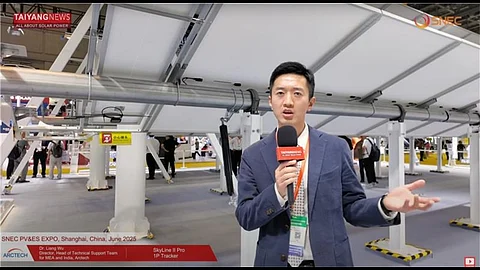

Arctech displayed its SkyLine II Pro series 1P tracker, suitable for ground-mount PV installations
The company also promoted the SkyFly series flexible tracking system, compatible with mountainous terrain
It also highlighted its lightweight and intelligent Star Shine I Series PV cleaning robot at the event
Given the evolving trend in variance of site-specific requirements for utility PV projects, such as terrain conditions, climate, and the scale of the project, solar tracker manufacturer Arctech showcased its latest offerings at SNEC 2025. The company also displayed its PV cleaning robot and an energy storage system (ESS).
During a brief conversation with TaiyangNews, Liang Wu, Director and Head of the Technology Support Team for MEA and India, walked through the company’s latest exhibits at the show.
Wu introduced the company’s latest 1P (one-in-portrait) trackerseries, SkyLine II Pro, displayed at its booth.
According to the product datasheet, each row of the tracker, installed horizontally relative to the ground, is designed to rotate the 1P mounted modules along a single axis. While Wu didn’t specify the maximum adaptable size of a module, he mentioned that it can accommodate up to 120 pieces, with a system voltage range of 300 V to 1,000 V DC. Driven by an integrated synchronous multi-point slew drive mechanism, its square shaped steel torque tube can rotate the mounted modules for up to 60° in either direction, aligning with the Sun’s movement. This slew drive mechanism involves 4 slew drives, connected at intermediate distances along the torque tube, and integrated with a common transmission rod. During operation, all connected slew drives, rotating in sync, enable uniform movement across the entire row of the tracker. In addition to its drive mechanism, the tracker’s intelligent controller maintains real-time tracking accuracy to within 2°, claims the company. The intelligent controller, typically powered by the connected string, features a control algorithm that works in a closed loop based on an astronomical algorithm and feedback from the tilt sensor.
Thanks to a terrain-adaptive intelligent algorithm, the tracker’s backtracking function can optimize power generation in undulating terrain during low-light conditions, like at dawn or dusk, noted Wu. It is engineered to withstand wind speeds up to 70 m/s. Beyond this threshold, the tracker switches to Wind Stow Mode, placing the system in a low tilt stow angle. The tracker can be enabled with additional safety features, upon request, for extreme environmental events, like floods, heavy snowfall, or hailstorms. In the flood mode, the tracker is placed in a flat position, while the snow mode lifts it to a maximum tilt angle. As of the time of publishing this article, the datasheet doesn’t mention the actual achievable tilt angle under snow mode.
Sharing the advantages related to installation and commissioning, Wu emphasized that the tracker’s in-built terrain-following feature allows installation by closely following the undulation of the terrain. This, in turn, saves earthworks during the installation phase in comparison to traditional models, he added.
The SkyFly series flexible tracking system displayed at the expo features 4 cable structures that are erected by a dual anchoring system. According to the company, it can support spans of up to 35 meters with a maximum ground clearance of 10 meters, making it suitable for installations in mountainous terrain. Designed to accommodate a multi-span structure in a single row, the tracker is driven by a mechanical drive mechanism. The synchronization of the multipoint drive mechanism is based on the LoRa wireless communication protocol. It supports a maximum of 168 modules and has a tracking angle range of ±45°. According to the company, its operating temperature range of between -20°C and +60°C ensures operation in cold climates.
Wu added that the tracker can achieve a tracking accuracy of less than 2° from the set angle, thanks to its integrated electronic control system and control algorithm. Similar to SkyLine II Pro, it offers terrain-adaptive backtracking functionality, along with an optional stow mode for flood and snowfall events.
Alongside the PV tracker lineup, Arctech showcased the Star Shine I series intelligent and lightweight PV cleaning robot. With dimensions of 2,685 × 495 × 430 mm (L × W × H) and weighing 38 kg, this robot features water-free dry cleaning. Its autonomous dual-system linkage control allows the robot to navigate an optimized cleaning path at speeds of 10 to 18 m/min, all while in sync with the tracker system. According to its datasheet, this system can deliver more than 99.5% water-free cleaning efficiency, thanks to its adaptability to inclination angles ranging from 10° to 30°.
The traversing path of the robot might experience multiple obstacles, caused by module frame edges, mounting clamps, or cable trays. Apprehending these potential challenges in the movement of the rbot, it is engineered to overcome vertical obstacle height not exceeding 50 mm. For underlying surface, which is not flat but slightly twisted, one side is higher or lower than the other, Cross Twisting or torsional distortion phenomenon occurs. This robot, designed to adapt +/- 20° cross-twisting, can traverse up to 20° of angular difference across its width, without being failed.
Equipped with a 24 V and 12 Ah / 24 Ah battery, the robot gets recharged on the docking station based on the contact charging mechanism.
Wu also highlighted the company’s yet-to-be-commercialized containerized ESS coupled with 1P tracker systems, which Arctech calls tracker storage. During shipping, all the torque tubes, piles, and modules are put together into the container that features a hybrid inverter and battery bank. Explaining this new product’s advantages, Wu noted that this containerized system, when placed in a greenfield project site that has no grid electricity, can support a 24 × 7 uninterrupted power supply.
The container is comprised of an inverter and a battery bank. According to Wu, this kind of innovative solution can be useful in places yet to be connected with electricity supply.
